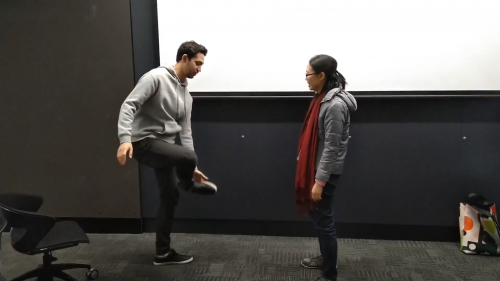Theme: Play & Time
Context:
After Matt gave his presentation, I was very keen on not going through my usual creative process of jumping onto the computer and making something I usually make. This led me down the path of thinking of physical games. As my studio project is about street and playground games, I recently watched this GDC talk where Doug Wilson (2013) talked about this Danish clapping game (around 40:45 mark in the video). This reminded me of how some hand-clapping games can be quite repetitive and loop over time. Doug also mentioned some lessons learnt from this folk game - such as how mimicking can be a lot of fun, and that humour and physicality go hand-in-hand. I want to capture this in my hand-clapping game.
I was also inspired by this Hong Kong game show I used to watch as a kid called the Super Trio show, where each contestant, in turn, picked a random word that began with the same letter as the last letter of the previous word, but also had to repeat the previous contestants' answers while adding their own (e.g. television -> number -> rabbit -> tea... etc.). After talking to Rachael, there is also a verbal game similar to this called 'I went to the supermarket...' which children would play and followed the same format.
Another inspiration, as Ben mentioned, is the game Simon Says, where we have to remember increasingly longer sequences.
Method:
Create a physical 2-player game, reminiscient of the hand-clapping games children used to play, that involves repetition and looping time.
Response:
After thinking it through, I decided to combine aspects of the Danish clapping game and the Super Trio game together to create my own physical game. I really liked the slapping lap action from the Danish clapping game as an anchor before each new action, so decided to use that as the basis of my Looper game. These are the rules:
- Two people stand opposite to each other.
- Person A starts by slapping their laps, then adding some physical action (e.g. clap once).
- Person B repeats this (slap lap -> clap once), then they slap their laps and add their own action (e.g. touch their nose).
- Person A repeats this sequence from the start (slap lap -> clap once -> slap lap -> touch nose), then add their own action.
- Repeat until someone forgets the sequence!
The attached video shows me playing the Looper Hand-Clapping Game with Ben and Amanda - special thanks to Rachael and Emmett for filming us! I also played this game with Yao, Sahaj, Fabian and Moon (not recorded), and they all responded quite positively to the game with lots of smile and laughter.
Music credits in video: If I Had a Chicken by Kevin MacLeod from the YouTube Audio Library
Reflection:
I started this week's exercise a bit stuck as I was purposefully trying to not go with my usual creative methods to think of new ideas. Designing physical games is something I'm not too familiar with, so I felt a bit scared and paralysed.
However, after overcoming this initial hurdle, and got the basics of the game sorted in my head, it was really fun to jump right into playtesting the game. Everyone who I played with seem to enjoy the game a lot - especially watching each others' actions and reactions and laughing when we forget the next step or struggle to remember the sequence. I also liked the simplicity of the game and how it doesn't require any additional props. Both Ben and Amanda enjoyed playing strategically and adding in complex actions to confuse me (haha).
I also thought it was interesting how the roles of this two-player game are constantly switching, from being observed to being the observer, and vice versa. Each player takes on the roles of both "actor" and "counteractor" in social play (Salen & Zimmerman 2004), teasing the other with a difficult move only having to repeat that when the roles switch.
Some suggestions on how to improve the game in its next iteration include: explaining a bit more clearly the need for the double slap on the lap before each new action, and also allow for players to mirror each others actions (rather than keeping with each's right/left side which can get confusing) that will also utilise our mirror neurons - leading to a simpler gameplay. Would love to try this out next time.
Overall, I felt the response addressed the theme of looping and repetition in a simple and playful way - like a physical interpretation of looping in programming. It was interesting that Sahaj, who has a programming background, also thought of each action like a programmer thinking through loops. I was especially drawn to the real-time feedback and social interaction of playing this physical games - like when we laugh at ourselves when we forget the next step, or strategically throwing the other person off with an unexpected action that hasn't been played before.
I thought this process of designing a physical game will also be helpful for my studio project, which involves making a physical game that includes digital components. As I don't have any prior experience designing physical games, this was really good practice!
References:
Salen, K & Zimmerman, E 2004, Rules of Play: Game Design Fundamentals, MIT Press, London.
Wilson, D 2013, Three Folk Games to Inspire Radical New Video Games, GDC Vault, San Francisco, viewed 28 July 2019, <https://www.gdcvault.com/play/1017749/Three-Folk-Games-to-Inspire>.
About This Work
By Helen Kwok
Email Helen Kwok
Published On: 01/08/2019
academic:
mediums:
interactive, live action, physical

